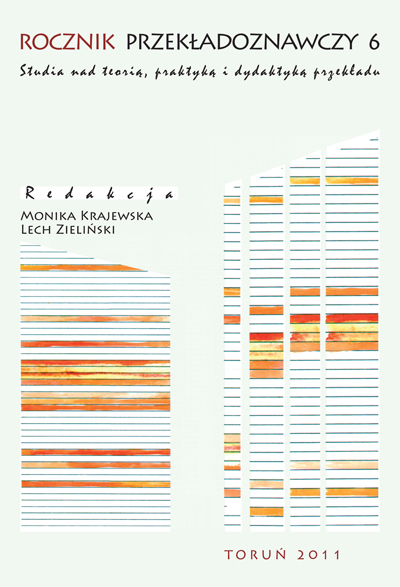Quality of legal translation in light of PN-EN 15038 standard of translation services and hypothesis of translation universals
DOI:
https://doi.org/10.12775/RP.2011.002Keywords
legal translation, translation evaluation, PN-EN 15038 standardAbstract
The paper discusses the quality of legal translation under the EN 15038 standard of translation services and the hypotheses of translation universals. The standard, Translation services – Service requirements, offers a holistic approach to quality at all stages of translation service provision, viewing translation proper as one of the stages only. It specifies quality assurance procedures, one of which is obligatory revision of translation by another translator which involves a check of the target text (TT) against the source text (ST), i.e. “the four-eye principle”. Chesterman’s division of translation universals into S-universals and T-universals raises our awareness of two inseparable sides of specialised translation: the equivalence relation (the ST-TT relation) and the relation of textual fit between the TT/translationese and naturally occurring non-translated target language. The equivalence relation, which is of priority in legal translation, involves the accuracy of information transfer as well as adequate and consistent use of specialised terms. Given the risk of failure to transfer the information content of the ST to the TT, the independent revision requirement seems to be perfectly suited to legal translation, in particular translation of the law and certified translation. The relation of textual fit concerns naturalness of translation and is achieved through grammatical, lexical, phraseological, typographical and stylistic correctness. The weight of the two dimensions depends on the purpose and status of the translation and its target group.
References
Alcaraz Varó, E., Hughes, B., 2002, Legal Translation Explained, Manchester, St. Jerome.
Baker, M., 1996, „Corpus-based translation studies: the challenges that lie ahead”, [w:] Terminology, LSP and Translation. Studies in Language Engineering in Honour of Juan C. Sager, H.L. Somers (red.), Amsterdam–Philadelphia, John Benjamins, s. 175–186.
Bhatia, V.K., 2006, „Legal Genres”, [w:] Encyclopedia of Language and Linguistics, t. 7, K. Brown (red.), Oxford, Elsevier, s. 1–7.
Biel, Ł., 2010, „Corpus-Based Studies of Legal Language for Translation Purposes: Methodological and Practical Potential”, [w:] Reconceptualizing LSP. Online proceedings of the XVII European LSP Symposium 2009, C. Heine, J. Engberg (red.), Aarhus, http://www.asb.dk/fileexplorer/fetchfile.aspx?file=16841 (dostęp: 9 lipca 2010 r.).
Biel, Ł., 2011, „Training translators or translation service providers? EN 15038:2006 standard of translation services and its training implications”, Journal of Specialised Translation, 16, s. 61–76.
Bonthrone, R., Fry D., 2004, „High-quality translation – the new localization paradigm”, [w:] Lisa Best Practice Guide: Quality Assurance – the Client Perspective, The Localization Industry Standards Association, s. 26–29.
Chesterman, A., 1997, Memes of Translation. The Spread of Ideas in Translation Theory, Amsterdam–Philadelphia, John Benjamins.
Chesterman, A., 2004, „Hypotheses about translation universals”, [w:] Claims, Changes and Challenges in Translation Studies. Selected contributions from the EST Congress, Copenhagen 2001, G. Hansen, K. Malmkjar, D. Gile (red.), Amsterdam–Philadelphia, John Benjamins, s. 1–13.
Cronin, M., 2003, Translation and Globalization, London, Routledge.
Kenny, D., 1998, „Equivalence”, [w:] Routledge Encyclopedia of Translation Studies, M. Baker (red.), London–New York, Routledge, s. 77–80.
Kierzkowska, D. (red.), 2005, Kodeks tłumacza przysięgłego z komentarzem, Warszawa, Wydawnictwo Tepis.
Kierzkowska, D., 2010, „Problemy praktyki zawodowej tłumacza przysięgłego, Biuletyn TEPIS, nr 72, Warszawa, s. 24–26.
Kotler, P., Keller, K.L., 2006, Marketing Management, wyd. 12, New Jersey, Pearson.
Kubacki, A.D., 2008, „Odpowiedzialność zawodowa tłumaczy przysięgłych”, [w:] Język, komunikacja, informacja, P. Nowak, P. Nowakowski (red.), Poznań, Sorus, s. 149–161.
Martin, T., 2007, „Managing risks and resources: a down-to-earth view of revision”, Journal of Specialised Translation, 8, s. 57–63.
Mauranen, A., 2006, „Translation universals”, [w:] Encyclopedia of Language and Linguistics, t. 13, K. Brown (red.), Oxford, Elsevier, s. 93–100. PN-EN 15038 Usługi tłumaczeniowe – Wymagania dotyczące świadczenia usług, 2006, Warszawa, Polski Komitet Normalizacyjny.
Poznański, P., 2010, „Taniej nie będzie, bo zawiódł tłumacz?”, Gazeta Wyborcza z 19 lutego 2010 r., s. 32.
Pym, A., 2004, „Text and risk in translation”, http://www.tinet.cat/~apym/online/translation/risk_analysis.pdf (dostęp: 9 lipca 2010 r.).
Szymowski, L., 2010, „300 tys. zł «wyparowało» z powodu «zmęczenia»”, http://wiadomosci.onet.pl/2122144,11,300_tys_zl_wyparowalo_z_powodu_zmeczenia,item.html (dostęp: 2 lutego 2010 r.).
Šarčević, S., 2000, „Legal Translation and Translation Theory: a Receiveroriented Approach”, Geneve, Actes, www.tradulex.org (dostęp: 4 sierpnia 2008 r.).
Tymoczko, M., 2005, „Trajectories of Research in Translation Studies”, Meta L, 4, s. 1082–1097.
Uhlig, D., 2005, „Błąd na błędzie w tłumaczeniach unijnych aktów”, Gazeta Wyborcza, http://wyborcza.pl/1,75248,2485538.html (dostęp: 9 lipca 2010 r.).
Downloads
Published
Issue
Section
Stats
Number of views and downloads: 1461
Number of citations: 0



